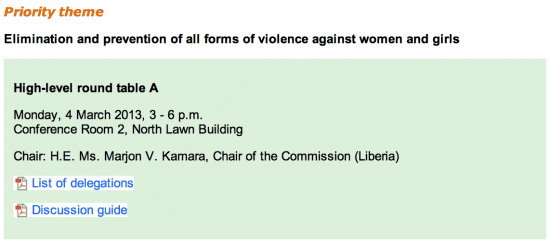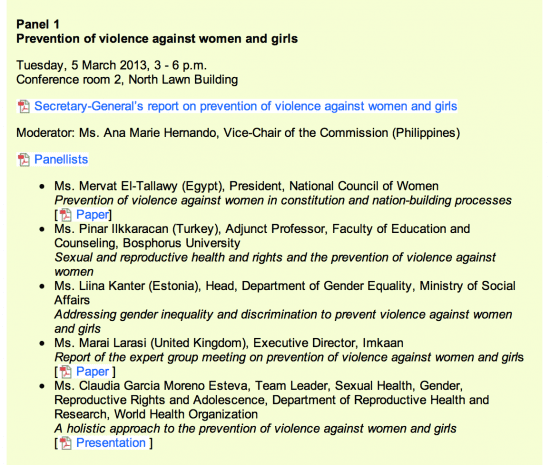As we embark on our third day at the United Nations Commission on the Status of Women 57th Session, here in New York, I take a quick look back at the first two days.
On Monday we queued for ca. 2 hours to get all the passes needed to move freely on UN premises and to attend government events. This year we feel that it is most important to attend events by and with governments because we are analysing and assessing where decision-makers from around the world stand in terms of working with primary prevention measures against violence against women and girls.
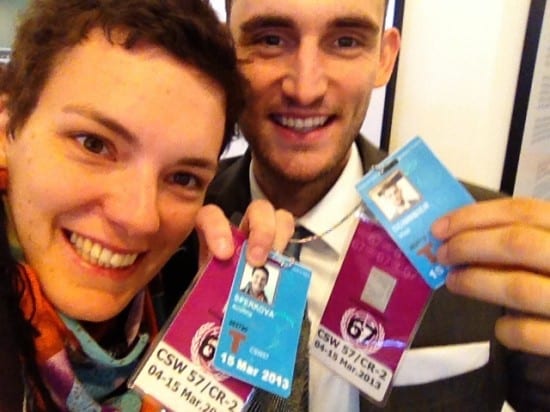
Happy with ground pass and secondary pass #CSW57
The vast majority of my advocacy trips, meetings and events I have had in Europe and even within the European Union. So as you could read earlier to be able to come to the United Nations and work here is a dream come true. It’s huge. Being inside the UN then really has given me another glimpse of reality: it’s not so fresh – to put it frankly. The buildings and facilities are old and are battered, paint falling of the walls. This is of course a realisation that doesn’t affect our advocacy or anything in the bigger context but for me these impressions helped to make a little internal journey: the UN is a beautiful idea, but the Member States’ funding scarcity has negative impact in many different dimensions.
On Monday, after we had finally gone through all security checks and bureaucratic procedures, we attended the High-Level Roundtable on this year’s priority theme “Elimination of all forms of violence against women and girls”.
It was very interesting to listen to the different country delegations and their statements on how they work to eliminate and prevent violence against women and girls. I am pretty critical towards many of the EU countries, and the EU itself because they use fancy words, but as we know action on addressing factors that prevent violence against women and girls, like alcohol policy measures, is not taken in a comprehensive way.
The Irish EU representative spoke about violence against women being a top priority in the EU. Is it? He also spoke about the EU investing tens of millions of Euros around the world to protect women from violence. While that is the case, the EU is also pushing policies that pressure low- and middle-income countries to open their markets to alcohol, which is clearly related to gender-based violence.
The first highlight was then the delegation of Uganda that clearly addressed alcohol in its statement and that brought to everybody’s attention that alcohol use must be part of the picture when preventing and eliminating violence against women and girls.
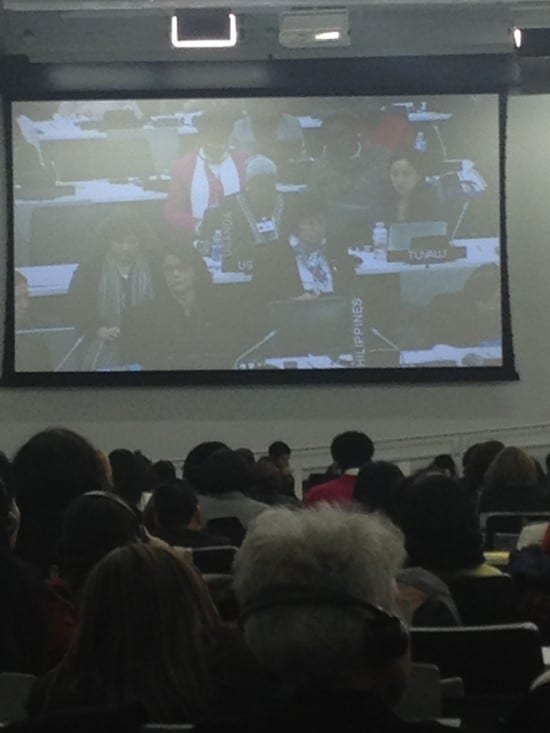
Uganda #CSW57 High-Level Roundtable
I also have to say that I admire the stance the Scandinavian countries are taking in this issue: the corporal punishment against children and women is a crime. Full stop. Domestic violence is a crime, not a private matter. And Norway also made it clear that gender-based violence is a huge economic issue: it costs Norway $1 billion annually. I think it is powerful to be able and willing to name things as they are and to move from there to mobilizing political will to address the problem. The problems we face in human societies around the world are made by humans and all can be solved by humans – as soon as we are willing to.
In that spirit we continued our work at the CSW57 on Tuesday at the Panel 1 on Prevention of violence against women and girls.
This was a fantastic event to attend. First of all, it was more interactive than the “roundtable” on Monday and second of all it focused on prevention of violence and every time there’s focus and a tighter frame, it’s actually possible to understand who is doing what and what not. Thirdly the panelists did a marvellous job, too.
We had to sit in the “overflow” room for civil society and watched the panel from there on huge screens. It was actually right opposite the meeting room, and an identical room with all the country signs; and we could and did even enter the meeting room to mingle with governments and panelists.
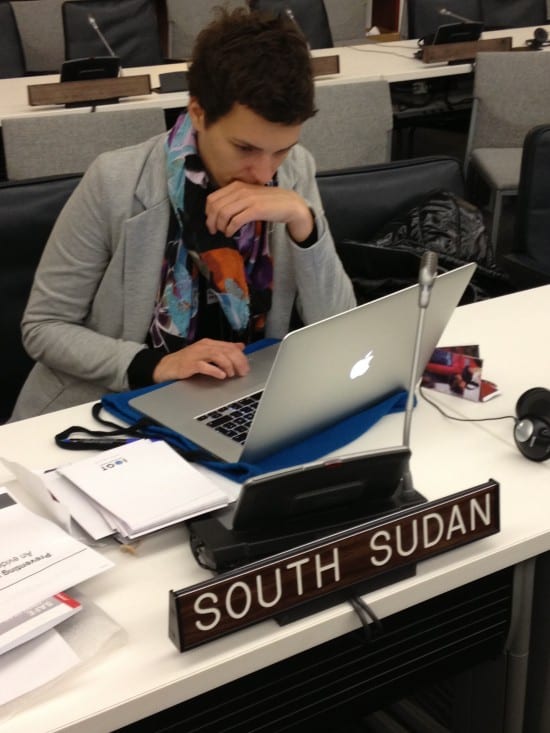
Representing…
So while we had to sit in the back of the meeting room on Monday, without interpretation service, we could enjoy interpretation and a table in front of us on Tuesday. It is pretty cool to follow the discussions live and to have the documents in front of you at the same time. Two presentations stood out, according to me.
Ms. Marai Larasi (United Kingdom), Executive Director, Imkaan, who presented a condensed version of the “Report of the expert group meeting on prevention of violence against women and girls” and who said among other that there is still divergent understanding of what prevention means, which has been one of the main obstacles to put in place effective and sustainable prevention measures to combat gender-based violence. And she explained that prevention is now on the rise, as governments understand it is not only a Human Rights issue but even an economic issue – preventing harm is more humane, more just and more economically sound than paying for treating harm.
For us it was very valuable to follow her reasoning and the learn about the work that has been done by her and an expert panel because clearly prevention measures as part of a holistic approach is now on the rise as governments start looking into how to ensure longevity and sustainability of action to prevent and eliminate violence against women. For us in IOGT it means a great opportunity to contribute with our know-how and expertise.
Ms. Claudia Garcia Moreno Esteva, Team Leader, Sexual Health, Gender, Reproductive Rights and Adolescence, Department of Reproductive Health and Research, World Health Organization, who presented WHO findings on “A holistic approach to the prevention of violence against women and girls”.
The first key message to governments was that we know more than ever before, have more data than ever before, particularly concerning domestic violence and intimate partner violence. The causes of partner violence are multiple and intertwined – factors interact at multiple levels to place women at risk of abuse. So, the problem – as so often – is complex and there are no silver bullets but we have more knowledge of risk and protective factors and of promising approaches to prevention.
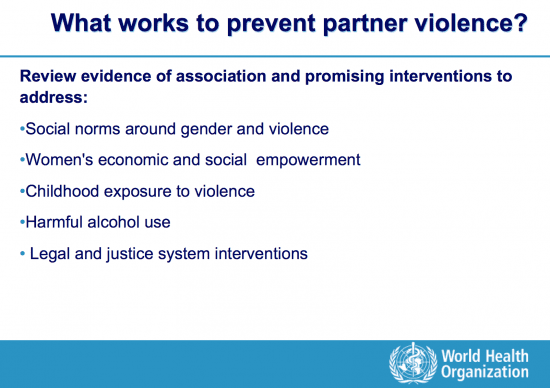
Holistic approach to preventing violence against women and girls
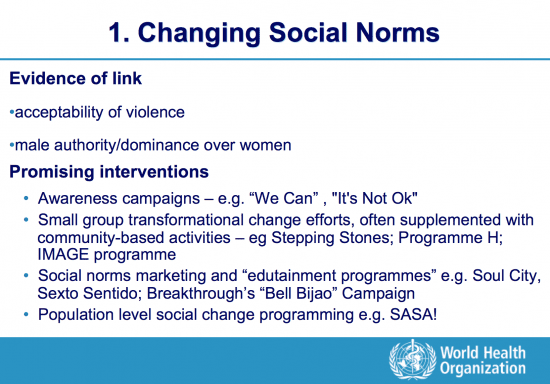
Changing culture and mind-sets for preventing VAW #CSW57
This slide is very important because many governments keep addressing the need for changing minds, for changing the way men and boys view females and how society at large treats women and girls. It means to change the culture and to abandon gender stereotypes.
We learned about a survey from the Swedish Minister for Equality conducted by the Swedish National Board for Youth Affairs concerning values towards gender equality among youth: those young people who hold more stereotypical attitudes, also use more violence.
That is why we need to ban alcohol marketing. When I discussed this after the event with Ms Moreno Garcia she agreed because of the objectification and sexualization that alcohol marketing portrays women and girls with.
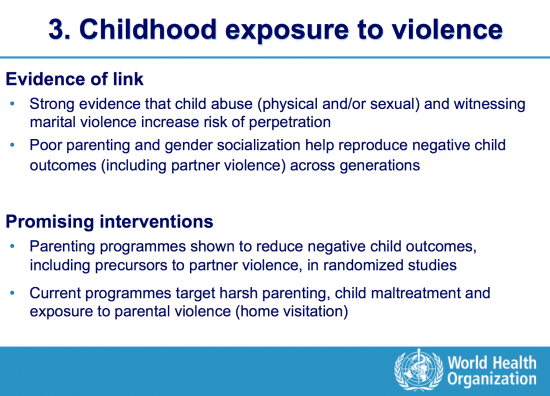
Holistic approach to preventing violence against women and girls
Also behind this slide there is an alcohol dimension, that the WHO did not address in the presentation itself. The more children are exposed to violence, especially domestic violence – be it as victims themselves or as witnesses – the higher is the likelihood that they become perpetrators themselves later in live. There are millions of children of alcoholics in the world who are exposed to domestic violence. Just to give you a few numbers on the issue:
In Australia the most recent study shows that between 17 to 34% (ca. 1 million children) live in households with at least one adult being addicted.
In the USA, mothers convicted of child abuse are 3 times more likely to be alcoholics and fathers 10 times more likely. More than half of all confirmed abuse reports and 75% of child deaths involve the use of alcohol or other drugs on the part of the parents. There are an estimated 26 million CoA in the USA.
In the European Union, there are at least 9 million children and young people growing up with alcohol-addicted parents.
And that means the fourth intervention will even have an impact on the first and third. The fourth intervention according to the WHO is:
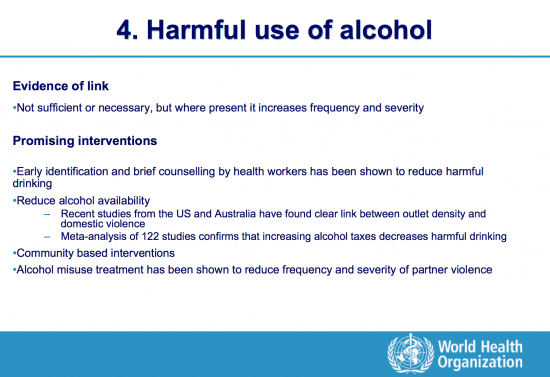
Less alcohol use, less violence, more freedom #CSW57
It is fantastic that this comes up and is addressed to the assembled governments at the CSW57. Evidence has been very clear that alcohol is a trigger for violence against women.
We also are clear, like the WHO, with saying that alcohol does not cause violence. But also triggers violent behaviour and the numbers of alcohol-related violent acts are staggering. Therefor alcohol policies like reducing availability, banning alcohol marketing, making alcohol less affordable are important measures that governments need to consider to protect children from exposure to domestic violence, to change mind-sets and a culture of objectification of women and girls and to reduce the overall use of alcohol, in order to reduce violence and allow more freedom for women and girls.
On Friday we will address this more detailed in our Parallel Event – right now we are sitting and preparing for it.
